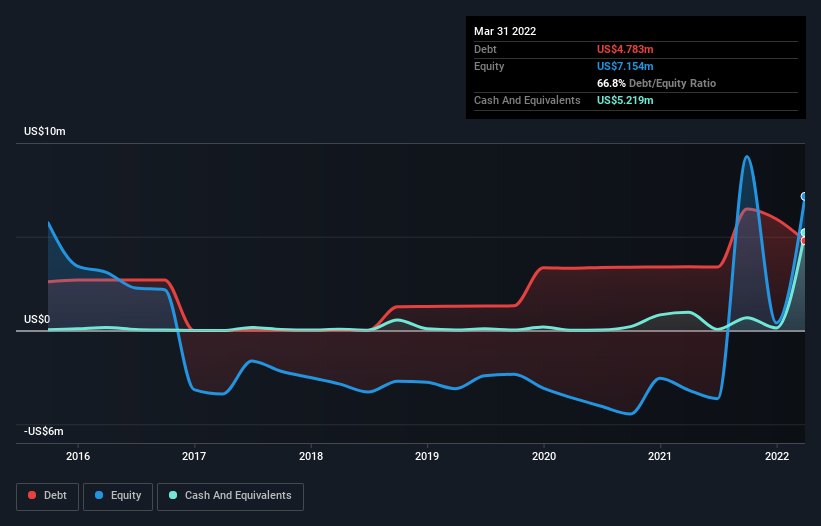Is Petro-Victory Energy (CVE:VRY) Weighed On By Its Debt Load?
Howard Marks put it nicely when he said that, rather than worrying about share price volatility, 'The possibility of permanent loss is the risk I worry about... and every practical investor I know worries about.' It's only natural to consider a company's balance sheet when you examine how risky it is, since debt is often involved when a business collapses. As with many other companies Petro-Victory Energy Corp. (CVE:VRY) makes use of debt. But the real question is whether this debt is making the company risky.
When Is Debt Dangerous?
Debt and other liabilities become risky for a business when it cannot easily fulfill those obligations, either with free cash flow or by raising capital at an attractive price. Ultimately, if the company can't fulfill its legal obligations to repay debt, shareholders could walk away with nothing. However, a more common (but still painful) scenario is that it has to raise new equity capital at a low price, thus permanently diluting shareholders. By replacing dilution, though, debt can be an extremely good tool for businesses that need capital to invest in growth at high rates of return. The first step when considering a company's debt levels is to consider its cash and debt together.
View our latest analysis for Petro-Victory Energy
What Is Petro-Victory Energy's Net Debt?
The image below, which you can click on for greater detail, shows that at March 2022 Petro-Victory Energy had debt of US$4.78m, up from US$3.40m in one year. But on the other hand it also has US$5.22m in cash, leading to a US$436.8k net cash position.
A Look At Petro-Victory Energy's Liabilities
We can see from the most recent balance sheet that Petro-Victory Energy had liabilities of US$1.73m falling due within a year, and liabilities of US$5.29m due beyond that. On the other hand, it had cash of US$5.22m and US$65.2k worth of receivables due within a year. So its liabilities outweigh the sum of its cash and (near-term) receivables by US$1.73m.
Given Petro-Victory Energy has a market capitalization of US$31.6m, it's hard to believe these liabilities pose much threat. However, we do think it is worth keeping an eye on its balance sheet strength, as it may change over time. Despite its noteworthy liabilities, Petro-Victory Energy boasts net cash, so it's fair to say it does not have a heavy debt load! There's no doubt that we learn most about debt from the balance sheet. But it is Petro-Victory Energy's earnings that will influence how the balance sheet holds up in the future. So if you're keen to discover more about its earnings, it might be worth checking out this graph of its long term earnings trend.
Over 12 months, Petro-Victory Energy reported revenue of US$1.1m, which is a gain of 171%, although it did not report any earnings before interest and tax. So its pretty obvious shareholders are hoping for more growth!
So How Risky Is Petro-Victory Energy?
We have no doubt that loss making companies are, in general, riskier than profitable ones. And the fact is that over the last twelve months Petro-Victory Energy lost money at the earnings before interest and tax (EBIT) line. Indeed, in that time it burnt through US$6.2m of cash and made a loss of US$3.6m. Given it only has net cash of US$436.8k, the company may need to raise more capital if it doesn't reach break-even soon. Importantly, Petro-Victory Energy's revenue growth is hot to trot. High growth pre-profit companies may well be risky, but they can also offer great rewards. The balance sheet is clearly the area to focus on when you are analysing debt. However, not all investment risk resides within the balance sheet - far from it. For example Petro-Victory Energy has 5 warning signs (and 2 which are a bit unpleasant) we think you should know about.
At the end of the day, it's often better to focus on companies that are free from net debt. You can access our special list of such companies (all with a track record of profit growth). It's free.
Have feedback on this article? Concerned about the content? Get in touch with us directly. Alternatively, email editorial-team (at) simplywallst.com.
This article by Simply Wall St is general in nature. We provide commentary based on historical data and analyst forecasts only using an unbiased methodology and our articles are not intended to be financial advice. It does not constitute a recommendation to buy or sell any stock, and does not take account of your objectives, or your financial situation. We aim to bring you long-term focused analysis driven by fundamental data. Note that our analysis may not factor in the latest price-sensitive company announcements or qualitative material. Simply Wall St has no position in any stocks mentioned.
Join A Paid User Research Session
You’ll receive a US$30 Amazon Gift card for 1 hour of your time while helping us build better investing tools for the individual investors like yourself. Sign up here

 Yahoo Finance
Yahoo Finance 
